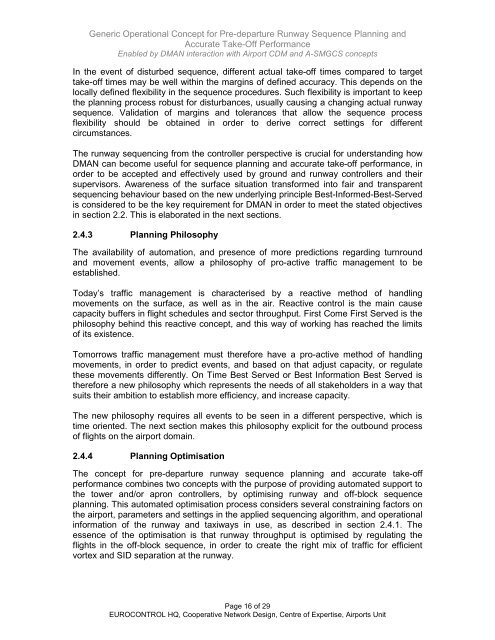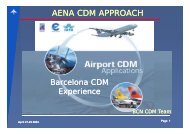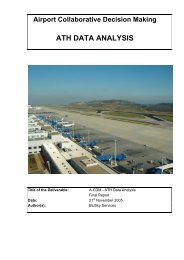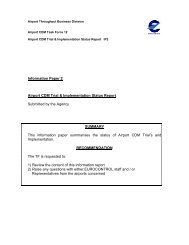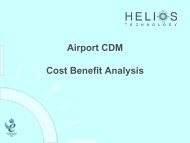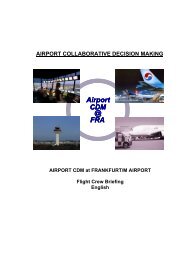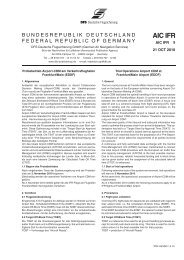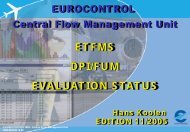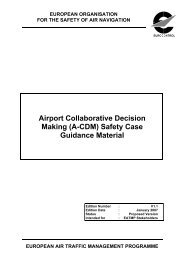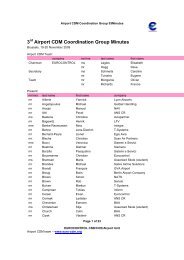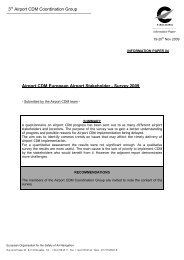Generic Operational Concept for DMAN Interaction v07A - Airport ...
Generic Operational Concept for DMAN Interaction v07A - Airport ...
Generic Operational Concept for DMAN Interaction v07A - Airport ...
You also want an ePaper? Increase the reach of your titles
YUMPU automatically turns print PDFs into web optimized ePapers that Google loves.
<strong>Generic</strong> <strong>Operational</strong> <strong>Concept</strong> <strong>for</strong> Pre-departure Runway Sequence Planning and<br />
Accurate Take-Off Per<strong>for</strong>mance<br />
Enabled by <strong>DMAN</strong> interaction with <strong>Airport</strong> CDM and A-SMGCS concepts<br />
In the event of disturbed sequence, different actual take-off times compared to target<br />
take-off times may be well within the margins of defined accuracy. This depends on the<br />
locally defined flexibility in the sequence procedures. Such flexibility is important to keep<br />
the planning process robust <strong>for</strong> disturbances, usually causing a changing actual runway<br />
sequence. Validation of margins and tolerances that allow the sequence process<br />
flexibility should be obtained in order to derive correct settings <strong>for</strong> different<br />
circumstances.<br />
The runway sequencing from the controller perspective is crucial <strong>for</strong> understanding how<br />
<strong>DMAN</strong> can become useful <strong>for</strong> sequence planning and accurate take-off per<strong>for</strong>mance, in<br />
order to be accepted and effectively used by ground and runway controllers and their<br />
supervisors. Awareness of the surface situation trans<strong>for</strong>med into fair and transparent<br />
sequencing behaviour based on the new underlying principle Best-In<strong>for</strong>med-Best-Served<br />
is considered to be the key requirement <strong>for</strong> <strong>DMAN</strong> in order to meet the stated objectives<br />
in section 2.2. This is elaborated in the next sections.<br />
2.4.3 Planning Philosophy<br />
The availability of automation, and presence of more predictions regarding turnround<br />
and movement events, allow a philosophy of pro-active traffic management to be<br />
established.<br />
Today’s traffic management is characterised by a reactive method of handling<br />
movements on the surface, as well as in the air. Reactive control is the main cause<br />
capacity buffers in flight schedules and sector throughput. First Come First Served is the<br />
philosophy behind this reactive concept, and this way of working has reached the limits<br />
of its existence.<br />
Tomorrows traffic management must there<strong>for</strong>e have a pro-active method of handling<br />
movements, in order to predict events, and based on that adjust capacity, or regulate<br />
these movements differently. On Time Best Served or Best In<strong>for</strong>mation Best Served is<br />
there<strong>for</strong>e a new philosophy which represents the needs of all stakeholders in a way that<br />
suits their ambition to establish more efficiency, and increase capacity.<br />
The new philosophy requires all events to be seen in a different perspective, which is<br />
time oriented. The next section makes this philosophy explicit <strong>for</strong> the outbound process<br />
of flights on the airport domain.<br />
2.4.4 Planning Optimisation<br />
The concept <strong>for</strong> pre-departure runway sequence planning and accurate take-off<br />
per<strong>for</strong>mance combines two concepts with the purpose of providing automated support to<br />
the tower and/or apron controllers, by optimising runway and off-block sequence<br />
planning. This automated optimisation process considers several constraining factors on<br />
the airport, parameters and settings in the applied sequencing algorithm, and operational<br />
in<strong>for</strong>mation of the runway and taxiways in use, as described in section 2.4.1. The<br />
essence of the optimisation is that runway throughput is optimised by regulating the<br />
flights in the off-block sequence, in order to create the right mix of traffic <strong>for</strong> efficient<br />
vortex and SID separation at the runway.<br />
Page 16 of 29<br />
EUROCONTROL HQ, Cooperative Network Design, Centre of Expertise, <strong>Airport</strong>s Unit


